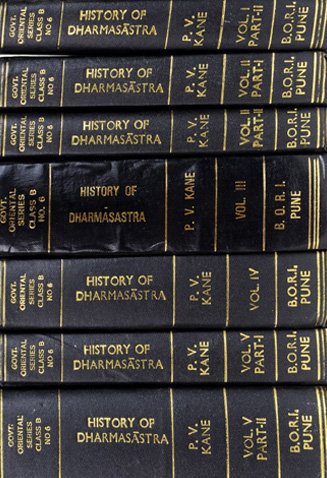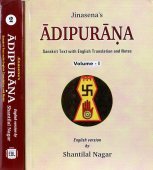Samvada, Saṃvāda, Shamvada, Samveda: 17 definitions
Introduction:
Samvada means something in Hinduism, Sanskrit, Jainism, Prakrit, Marathi, Hindi. If you want to know the exact meaning, history, etymology or English translation of this term then check out the descriptions on this page. Add your comment or reference to a book if you want to contribute to this summary article.
In Hinduism
Dharmashastra (religious law)
Source: Sacred Texts: The Grihya Sutras, Part 2 (SBE30)Saṃvāda (संवाद) refers to a “dialogue” used in the Yajurveda, according to the Āpastamba-yajña-paribhāṣā-sūtras.—“with the Yajur-veda the performance takes place by murmuring (upāṃśu). With the exception of addresses, replies, choosing of priests, dialogues (saṃvāda), and commands”.
As all these are meant to be understood by others, they have therefore to be pronounced in a loud voice. [...] A dialogue (saṃvāda) is “brahman prokṣishyāmi, om prokṣa”.

Dharmashastra (धर्मशास्त्र, dharmaśāstra) contains the instructions (shastra) regarding religious conduct of livelihood (dharma), ceremonies, jurisprudence (study of law) and more. It is categorized as smriti, an important and authoritative selection of books dealing with the Hindu lifestyle.
Purana and Itihasa (epic history)
Source: archive.org: Shiva Purana - English TranslationSaṃvāda (संवाद) refers to a “discourse”, according to the Śivapurāṇa 2.3.13 (“Śiva-Pārvatī dialogue”).—Accordingly, after Himācala (i.e., Himālaya) spoke to Śiva: “[...] O dear, at the bidding of lord Śiva , none of the Gaṇas, Nandīśvara and others, purely carrying out the orders of Śiva, prevented her. The discourse [i.e., saṃvāda] of Śivā and Śiva who represented the principles of Sāṃkhya and Vedanta and who, if thoughtfully considered, are not different from each other, was very happy and pleasing for ever. At the request of the lord of mountains, Śiva permitted Pārvatī to remain with Him being true to His words though with all gravity and seriousness. [...]”.

The Purana (पुराण, purāṇas) refers to Sanskrit literature preserving ancient India’s vast cultural history, including historical legends, religious ceremonies, various arts and sciences. The eighteen mahapuranas total over 400,000 shlokas (metrical couplets) and date to at least several centuries BCE.
Shaivism (Shaiva philosophy)
Source: SOAS University of London: Protective Rites in the Netra TantraSamvāda (सम्वाद) refers to “speaking ( in dreams)”, according to the Svacchanda-tantra.—Accordingly, [verse 4.7, while describing the interpretation of dreams]—“[The disciple] achieves success after speaking in dreams (samvāda—saha samvādaṃ kṛtvā svapne) with princes, Ṛsis, Gods, Siddhas, Vidyāharas, Gaṇas, and teachers”.

Shaiva (शैव, śaiva) or Shaivism (śaivism) represents a tradition of Hinduism worshiping Shiva as the supreme being. Closely related to Shaktism, Shaiva literature includes a range of scriptures, including Tantras, while the root of this tradition may be traced back to the ancient Vedas.
In Jainism
General definition (in Jainism)
Source: academia.edu: Tessitori Collection ISaṃvāda (संवाद) refers to “debate” (e.g., ‘a succession of monologues taking place during a samavasaraṇa), according to the “Dānasīlatapabhāvanā ko coḍhālau” by Samayasundara (dealing with the Ethics section of Jain Canonical literature), which is included in the collection of manuscripts at the ‘Vincenzo Joppi’ library, collected by Luigi Pio Tessitori during his visit to Rajasthan between 1914 and 1919.—The first verse introduces the term saṃvāda ‘debate’. Indeed the poem represents this literary genre very popular in Medieval Gujarati literature where various abstract notions quarrel about which one is the best in a succession of monologues taking place during Mahāvīra’s samavasaraṇa. Here the first to speak is dāna ‘generosity, religious gift to Jain monks’ which extols its own merits and refers to emblematic heroes such as Śālibhadra, Mūladeva, etc. Then comes sīla ‘moral virtue’, followed by tapas ‘ascetic practices, fast’ and bhāvanā ‘concentration, meditation’. The debate is concluded by the Jina who says that the four of them form what is the Jina’s dharma, and that from dharma comes all happiness and liberation.

Jainism is an Indian religion of Dharma whose doctrine revolves around harmlessness (ahimsa) towards every living being. The two major branches (Digambara and Svetambara) of Jainism stimulate self-control (or, shramana, ‘self-reliance’) and spiritual development through a path of peace for the soul to progess to the ultimate goal.
Languages of India and abroad
Marathi-English dictionary
Source: DDSA: The Molesworth Marathi and English Dictionarysaṃvāda (संवाद).—m (S sam & vāda) Conference, colloquy, converse.
Source: DDSA: The Aryabhusan school dictionary, Marathi-Englishsaṃvaḍa (संवड).—f An interval of leisure or convenience. Spare room. Place of influence.
--- OR ---
saṃvāda (संवाद).—m Conference, converse.
Marathi is an Indo-European language having over 70 million native speakers people in (predominantly) Maharashtra India. Marathi, like many other Indo-Aryan languages, evolved from early forms of Prakrit, which itself is a subset of Sanskrit, one of the most ancient languages of the world.
Sanskrit dictionary
Source: DDSA: The practical Sanskrit-English dictionarySaṃvāda (संवाद).—
1) Speaking together, conversation, dialogue, colloquy; सकृत्संवादेऽपि प्रथत इह चामुत्र च शुभम् (sakṛtsaṃvāde'pi prathata iha cāmutra ca śubham) Mv.1.12.
2) Discussion, debate.
3) Communication of tidings.
4) Information, news.
5) Assent, concurrence.
6) Likeness, agreement, similarity, correspondence; तद्धित्वा- ऽमृतसंवादं तस्मादेतौ मताविह (taddhitvā- 'mṛtasaṃvādaṃ tasmādetau matāviha) Mahābhārata (Bombay) 12.167.24; रूपसंवादाच्च संशयादनया पृष्टः (rūpasaṃvādācca saṃśayādanayā pṛṣṭaḥ) Dk.; (nādaḥ) चित्ताकर्षी परिचित इव श्रोत्रसंवाद- मेति (cittākarṣī paricita iva śrotrasaṃvāda- meti) Mālatīmādhava (Bombay) 5.2.
7) Meeting, encounter; यदृच्छासंवादः किमु किमु गुणानामतिशयः (yadṛcchāsaṃvādaḥ kimu kimu guṇānāmatiśayaḥ) Uttararāmacarita 5.16.
8) A cause, law-suit.
Derivable forms: saṃvādaḥ (संवादः).
Source: Cologne Digital Sanskrit Dictionaries: Shabda-Sagara Sanskrit-English DictionarySaṃvāda (संवाद).—m.
(-daḥ) 1. Communication of intelligence, information, news. 2. Assent, concurrence. 3. Conformity, correspondence, sameness. 4. Conversation, dialogue. 5. Discussion. E. sam with vad to speak, aff. ghañ .
Source: Cologne Digital Sanskrit Dictionaries: Benfey Sanskrit-English DictionarySaṃvāda (संवाद).—i. e. sam-vad + a, m. 1. Conversation, [Pañcatantra] 118, 25. 2. Communication of intelligence, information, [Mālatīmādhava, (ed. Calc.)] 80, 5. 3. Assent, agreement, [Mālavikāgnimitra, (ed. Tullberg.)] 72, 8. 4. Conformity, correspondence, sameness.
Source: Cologne Digital Sanskrit Dictionaries: Cappeller Sanskrit-English DictionarySaṃvāda (संवाद).—[masculine] speaking together, conversation with ([instrumental] ±saha, [locative], or —°); agreement, correspondence, sameness.
Source: Cologne Digital Sanskrit Dictionaries: Monier-Williams Sanskrit-English Dictionary1) Śaṃvada (शंवद):—[=śaṃ-vada] [from śaṃ > śam] m., [Pāṇini 3-2, 14 [Scholiast or Commentator]]
2) Saṃvāda (संवाद):—[=saṃ-vāda] [from saṃ-vad] m. (ifc. f(ā). ) speaking together, conversation, colloquy with ([instrumental case] with and without saha [locative case], or [compound]), [Ṛg-veda] etc. etc.
3) [v.s. ...] appointment, stipulation, [Kātyāyana-śrauta-sūtra; Kāvya literature; Varāha-mihira’s Bṛhat-saṃhitā]
4) [v.s. ...] a cause, lawsuit, [Āpastamba-gṛhya-sūtra; Kathāsaritsāgara]
5) [v.s. ...] assent, concurrence, agreement, conformity, similarity, [Horace H. Wilson]
6) [v.s. ...] information, news, [ib.]
Source: Cologne Digital Sanskrit Dictionaries: Yates Sanskrit-English DictionarySaṃvāda (संवाद):—[saṃ-vāda] (daḥ) 1. m. Communication of intelligence or news; agreeing or tallying with.
Source: DDSA: Paia-sadda-mahannavo; a comprehensive Prakrit Hindi dictionary (S)Saṃvāda (संवाद) in the Sanskrit language is related to the Prakrit words: Saṃvāda, Saṃvāya.
[Sanskrit to German]
Sanskrit, also spelled संस्कृतम् (saṃskṛtam), is an ancient language of India commonly seen as the grandmother of the Indo-European language family (even English!). Closely allied with Prakrit and Pali, Sanskrit is more exhaustive in both grammar and terms and has the most extensive collection of literature in the world, greatly surpassing its sister-languages Greek and Latin.
Hindi dictionary
Source: DDSA: A practical Hindi-English dictionarySaṃvāda (संवाद) [Also spelled samvad]:—(nm) a dialogue; conversation, discussion; news; information, message; ~[dātā] a correspondent, pressman; [hara] a messenger.
...
Prakrit-English dictionary
Source: DDSA: Paia-sadda-mahannavo; a comprehensive Prakrit Hindi dictionarySaṃvāda (संवाद) in the Prakrit language is related to the Sanskrit word: Saṃvāda.
Saṃvāda has the following synonyms: Saṃvāya.
Prakrit is an ancient language closely associated with both Pali and Sanskrit. Jain literature is often composed in this language or sub-dialects, such as the Agamas and their commentaries which are written in Ardhamagadhi and Maharashtri Prakrit. The earliest extant texts can be dated to as early as the 4th century BCE although core portions might be older.
Kannada-English dictionary
Source: Alar: Kannada-English corpusSaṃvāda (ಸಂವಾದ):—
1) [noun] a speaking together; conversation; colloquy.
2) [noun] a discussion, as of a public question in an assembly, involving opposing viewpoints; a debate.
3) [noun] a lengthy discussion of an important question in which opposing opinions clash; a controversy.
4) [noun] the state or quality of being similar; resemblance or likeness; similarity.
5) [noun] a point, feature or instance in which things are similar; similarity.
6) [noun] the state of being coordinate; harmonious adjustment or action; co-ordination.
7) [noun] news; information; tidings.
8) [noun] approval; assent; consent.
--- OR ---
Saṃvēda (ಸಂವೇದ):—
1) [noun] knowledge perceived through the senses.
2) [noun] intelligence; acumen; judgement; reasoning ability.
Kannada is a Dravidian language (as opposed to the Indo-European language family) mainly spoken in the southwestern region of India.
See also (Relevant definitions)
Partial matches: Sam, Vada, Vata.
Starts with: Camvatam, Samvada-samiti, Samvadabhijayana, Samvadacintamani, Samvadada, Samvadadata, Samvadaka, Samvadakala, Samvadana, Samvadanashila, Samvadanashile, Samvadara, Samvadarthi, Samvadasundara, Samvadatmaka, Samvatam, Samvedane.
Ends with (+47): Ashtadashasamvada, Avisamvada, Bahulavyaghrasamvada, Bhagavanandasamvada, Bhagavannandasamvada, Bhasavilasasamvada, Bhrigubharatasamvada, Brahmanaradasamvada, Candalayudhishthirasamvada, Colarenukasamvada, Cyavananahushasamvada, Dadhicakshupasamvada, Dattatreyagorshasamvada, Dharanivarahasamvada, Dharmasamvada, Dharmayudhishthirasamvada, Dherandacandasamvada, Gurushishyasamvada, Hamsasamvada, Hanamadangadasamvada.
Full-text (+191): Samvadika, Sasamvadam, Yadricchasamvada, Samvadin, Visamvada, Upasamvada, Samvadita, Samvaditri, Samvadabhijayana, Yathasamvadam, Samvadana, Samvadaka, Samvadya, Tadita, Suryarunasamvada, Samvaya, Kakarudrasamvada, Bhrigubharatasamvada, Shukasamvada, Hanumadangadasamvada.
Relevant text
Search found 39 books and stories containing Samvada, Śaṃ-vada, Sam-vada, Saṃ-vāda, Saṃvāda, Saṃvaḍa, Śaṃvada, Samvāda, Samveda, Saṃvēda, Samvēda, Sham-vada, Shamvada; (plurals include: Samvadas, vadas, vādas, Saṃvādas, Saṃvaḍas, Śaṃvadas, Samvādas, Samvedas, Saṃvēdas, Samvēdas, Shamvadas). You can also click to the full overview containing English textual excerpts. Below are direct links for the most relevant articles:
Samkhya thoughts in the Mahabharata (by Shini M.V.)
Bharadvāja Bṛgu Saṃvāda < [Chapter 3 - The Philosophical Tenets in the Śānti-parva]
Thirty-eight Tattvas of Sāṃkhya philosophy < [Chapter 4 - Sāṃkhya thoughts in the Śānti-parva of Mahābhārata]
The Brahmanda Purana (by G.V. Tagare)
Brihad Bhagavatamrita (commentary) (by Śrī Śrīmad Bhaktivedānta Nārāyana Gosvāmī Mahārāja)
Verse 2.1.3 < [Chapter 1 - Vairāgya (renunciation)]
Verse 1.1.15-17 < [Chapter 1 - Bhauma (the earthly plane)]
Verse 1.3.44 < [Chapter 3 - Prapañcātīta (beyond the Material Plane)]
Shrimad Bhagavad-gita (by Narayana Gosvami)
Verse 18.70 < [Chapter 18 - Mokṣa-yoga (the Yoga of Liberation)]
Verse 18.76 < [Chapter 18 - Mokṣa-yoga (the Yoga of Liberation)]
Verse 18.74 < [Chapter 18 - Mokṣa-yoga (the Yoga of Liberation)]
Mahabharata (English) (by Kisari Mohan Ganguli)
Draupadi-Satyabhama Samvada < [Book 3 - Vana Parva]
Mahabharata (English Summary) (by Kisari Mohan Ganguli)
Draupadi-Satyabhama Samvada < [Book 3 - Vana Parva]
Related products
